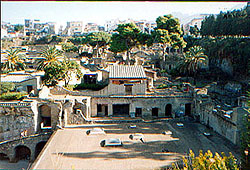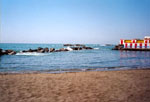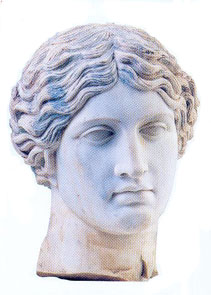

To live an unforgettable and magic experience, have a look at our guided tours
The ancient town of Herculaneum was destroyed and buried, together with Pompei, Oplontis, Stabiae and other small villages, by the eruption of Mount Veusvius in A.D. 79. It completely disappeared under a thick layer of volcanic material. The town was only accidently discovered in 1709 when a few workers, digging a well, detected a wall which was later identified with the stage of the ancient theatre. Regular excavations started, later, under the patronage of Charles III of the Bourbon family, the monarch of the Kingdom of Naples. The king appointed engineer Karl Weber as director of the excavations. Numerous buildings and manufacts were uncovered and Karl Weber documented all of them, but this was not sufficient to prevent that most of the artifacts were removed by treasure hunters. In early eighteenth century, archeology was just about to become a science, so when the uncovering of Herculaneum was undertaken, the archaeologists were not yet prepared to face the problems related to the removal of the volcanic material and although many buildings were found still in good conditions, the conservation of the top floors proved to be very difficult so that many of them were lost for ever. One of the most important and fascinating discoveries was that of the Villa of the Papyri, a superb suburban residence, where a large number of ancient papyri scrolls, written in Greek and Latin, were discovered together with marvellous bronzes and marble works. The ancient papyri, most of which dealing with the philosophical subjects of Epicurean inspiration, are still object of study and are preserved at the Archeological National Museum of Naples.
The excavations were discontinued and were alternatively abandoned and
resumed for almost two hundred years because of the difficulties given by the
compact mass of the pyroclastic material and the infiltration of water into the ruins.
They were resumed in 1927 under the direction of Amedeo Maiuri and most of the
public monuments of the old town were uncovered. The special condition under
which Herculaneum was buried preserved most of the buildings and allowed
the conservation of magnificent paintings, wooden furniture, pieces of cloth
and splendid jewelleries which offer a detailed information about the life of
the old inhabitants of the Naples coast. This information are very difficulty
achieved in other centres of the ancient roman society. The excavations of Herculaneum, together with those of
Pompei, had in fact, precipitated the modern science of archeology, and are still continuing
but, although the ruins were declared a Unesco World Heritage Site, they are
bound restricted  by the presence of the inhabited dwellings of the present town. In 1981 the ancient beach was brought to light.
Many human skeletons were found inside the fornices that had been built close to the ancient shoreline, suggesting
that numerous inhabitants attempted to escape. Unfortunately they all perished because
of the pyroclastic flow and the volcanic gases which covered the town.
by the presence of the inhabited dwellings of the present town. In 1981 the ancient beach was brought to light.
Many human skeletons were found inside the fornices that had been built close to the ancient shoreline, suggesting
that numerous inhabitants attempted to escape. Unfortunately they all perished because
of the pyroclastic flow and the volcanic gases which covered the town.
 The
church, known as a Basilica, had been built in the village of Resina,
which is then considered to be one of the oldest medieval hamlets in
the Italian peninsula. Resina,
which had to face numerous eruptions of the volcano Vesuvius, was also
attacked
and besieged by different populations and it became a dukedom during
the Angevin
domination. Its population had to pay an incredible amount of money to
get freedom in 1699. During the eighteenth century, when the king of
Naples decided to build his Royal Palace in the nearby town of Portici,
a new era started
for the resort town of Resina. Many beautiful villas where built along
the so-called "Golden Mile" and Resina became one of the most famous
vacation site in the bay of Naples. The area was known to be a healthy
place and the king Ferdinand IV himself established his own dwelling
into a villa which resembled his Austrian wife's house, the Schonbrun
Palace in Vienna and this residence became Maria Carolina's favourite
villa. Villa Favorita, together
with other splendid villas, was used by many aristocrats and diplomats
and soon became the most famous and enjoyable place for a splendid
holiday. The town of Resina, thanks to its
superb location in the middle of the bay of Naples, became one of the
most famous destinations of the "Grand Tour". A funicular was built in the centre of the town , near the train station, in order to take tourists up on the slopes of the
Volcano and Resina became very famous all over the world for its
beautiful scenery. The two world wars caused the end of this golden age
for the aristocrats of the area and the town returned to its normal
life. In 1969 the Italian government decided to change the toponym Resina in that of Ercolano with a view to the glory of its ancient name.
The
church, known as a Basilica, had been built in the village of Resina,
which is then considered to be one of the oldest medieval hamlets in
the Italian peninsula. Resina,
which had to face numerous eruptions of the volcano Vesuvius, was also
attacked
and besieged by different populations and it became a dukedom during
the Angevin
domination. Its population had to pay an incredible amount of money to
get freedom in 1699. During the eighteenth century, when the king of
Naples decided to build his Royal Palace in the nearby town of Portici,
a new era started
for the resort town of Resina. Many beautiful villas where built along
the so-called "Golden Mile" and Resina became one of the most famous
vacation site in the bay of Naples. The area was known to be a healthy
place and the king Ferdinand IV himself established his own dwelling
into a villa which resembled his Austrian wife's house, the Schonbrun
Palace in Vienna and this residence became Maria Carolina's favourite
villa. Villa Favorita, together
with other splendid villas, was used by many aristocrats and diplomats
and soon became the most famous and enjoyable place for a splendid
holiday. The town of Resina, thanks to its
superb location in the middle of the bay of Naples, became one of the
most famous destinations of the "Grand Tour". A funicular was built in the centre of the town , near the train station, in order to take tourists up on the slopes of the
Volcano and Resina became very famous all over the world for its
beautiful scenery. The two world wars caused the end of this golden age
for the aristocrats of the area and the town returned to its normal
life. In 1969 the Italian government decided to change the toponym Resina in that of Ercolano with a view to the glory of its ancient name.
For more detailed information please visit my site www.herculaneum.net/visitingHerculaneum.net
To see all my guided tours please visit my site mariasannino.com
If you are coming from a search engine please visit our home page otherwise return to top or to Herculaneum history
|
Home page
|
Top
|
